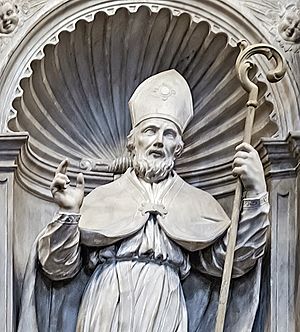Olegarius facts for kids
Quick facts for kids SaintOlegarius |
|
|---|---|
 |
|
| Born | 1060 Barcelona |
| Died | 6 March 1137 |
| Venerated in | Roman Catholic Church |
| Beatified | 25 May 1675, Rome, Papal States by Pope Clement X |
| Major shrine | side chapel of Christ of Lepanto, Cathedral of Barcelona |
| Feast | 6 March |
Saint Olegarius (born 1060, died 6 March 1137) was an important church leader in Spain. He served as the Bishop of Barcelona starting in 1116. Later, he also became the Archbishop of Tarragona in 1118. He was a close friend of Ramon Berenguer III, Count of Barcelona, and sometimes joined the count on military trips.
Olegarius became a saint in 1675. His main resting place and special shrine are in a chapel inside the Cathedral of Barcelona. People celebrate his feast day on 6 March, the day he passed away.
Contents
Early Life and Church Career
Olegarius was born into a noble family in Barcelona. His father worked for Ramon Berenguer I, Count of Barcelona. When Olegarius was ten, he joined the group of canon priests at the Cathedral of Barcelona.
He later became a leader (called a provost) for the canons in Barcelona and then in Sant Adrià de Besòs (from 1095 to 1108). After that, he became the abbot (leader) of the Augustinian monastery of Saint-Ruf in Avignon (from 1113 to 1118).
While he was abbot of Saint-Ruf, Olegarius helped create an alliance. This alliance brought together powerful groups like the Republic of Pisa and Barcelona. They worked together against pirates from the Almoravid group who were based in the Balearic Islands. This led to a big expedition against the pirates in 1113–1115.
Later, Olegarius joined a special group called the cofradía of San Pedro de la Portella. In 1116, Count Ramon Berenguer III chose him to be the Bishop of Barcelona. He officially became bishop in a ceremony in Maguelone, France. In 1117, he traveled to Rome to meet Pope Gelasius II.
A Leader for Church Reforms
As a church leader, Olegarius believed in making the church better. He often attended important church meetings called synods. He went to many of these meetings, including ones in Toulouse (1119), Rheims (1120), and the First Lateran Council in Rome (1123).
At the First Lateran Council, Olegarius was given a special role. He became a papal legate, meaning he was the Pope's representative for a Crusade in a new area of Catalonia called Tarragona. He then started using the title dispensator or rector of Tarragona.
At a meeting in Narbonne in 1129, a large group was formed to help rebuild the church in Tarragona. Olegarius had started this group a year earlier. Members, including regular people and church officials, paid fees to help his archdiocese. At the Council of Clermont in 1130, Olegarius likely met Bernard of Clairvaux. His ideas helped in the decision against a rival pope, Antipope Anacletus II.
In the 1120s, Olegarius also reformed the monastery of Santa Eulàlia near Barcelona. He changed it into a community of Augustinian canons. He was very involved in improving Augustinian monasteries in Catalonia.
Rebuilding Tarragona
After the city of Tarragona was taken back from the Moors, Olegarius became its archbishop on 8 March 1118. He remained the Bishop of Barcelona at the same time. Pope Gelasius, who had lived in Olegarius's monastery, confirmed his new role.
Count Ramon Berenguer III gave Olegarius full control over Tarragona and its surrounding areas. This was part of a plan to rebuild the region after it was re-conquered. Olegarius also received church rights over the area of Tortosa, which had not yet been fully conquered. He was a trusted advisor to both Ramon Berenguer III and his son, Ramon Berenguer IV, Count of Barcelona.
After a big defeat for Catalonia in the Battle of Corbins in 1124, Olegarius is said to have gone on a pilgrimage to the Holy Land. He cut his trip short in Antioch because he was worried about Tarragona. He returned by 1127.
Between 1126 and 1130, Olegarius worked hard to rebuild Tarragona, especially its churches. He also encouraged people to move there and settle the land. He worked to bring knights and soldiers to defend the new territory. In 1129, he gave his secular (non-church) authority in Tarragona to Robert Bordet. Olegarius then focused on restoring the main church leadership in the city.
Important Diplomatic Work
In 1129, Olegarius became involved in a big disagreement between the Pope and the Holy Roman Empire. He went to southern France to be with the Pope, who was in exile. He briefly returned to Barcelona and then to Castile in 1130 before going back to France.
He was back in Barcelona for a special meeting (a cort) in 1131. Here, Olegarius successfully asked for the return of a tax on the money earned from Barcelona's port. This tax had become more valuable because of a new trade agreement he had made with the Republic of Genoa.
Olegarius helped set up the Knights Templar in Catalonia in 1134. This group of knights was meant "to serve God and fight in our land." In 1122, he also signed a document to create a military group called the confraternity of Belchite.
In December 1134, Olegarius played a key role in making peace. He helped Ramiro II of Aragon and Alfonso VII of Castile end their conflict in Zaragoza. He also helped arrange important marriages, like the one between Douce I, Countess of Provence and Ramon Berenguer III.
See also
 In Spanish: Olegario para niños
In Spanish: Olegario para niños


